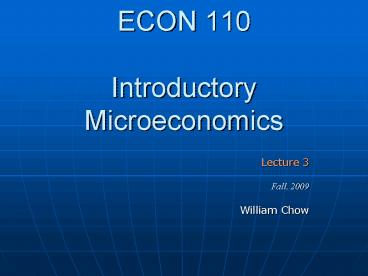ECON 110 Introductory Microeconomics - PowerPoint PPT Presentation
1 / 27
Title:
ECON 110 Introductory Microeconomics
Description:
The is a single point on the PPF that implies a special kind of ... pasta, mandarins, olives and wheat gluten will be more accessible to Chinese consumers. ... – PowerPoint PPT presentation
Number of Views:183
Avg rating:3.0/5.0
Title: ECON 110 Introductory Microeconomics
1
ECON 110Introductory Microeconomics
- Lecture 3
- Fall, 2009
- William Chow
2
Highlights
- Concept of Allocative Efficiency
- Implication of Economic Growth
- Comparative Advantage
- Absolute Advantage
3
Allocative Efficiency
- The is a single point on the PPF that implies a
special kind of efficiency that other points
dont - This point achieves what we call allocative
efficiency - To understand this, we need to introduce notions
of Marginal Cost and Marginal Benefit
4
Marginal Cost
- The marginal cost (MC) of a good or service is
the opportunity cost of producing one more unit
of it - Consider butter production in our example, the
slope of the PPF opportunity cost of producing
an additional unit of butter - An MC curve is like the following
5
(No Transcript)
6
Marginal Benefit
- The marginal benefit (MB) of a good or service is
the benefit received from consuming one more unit
of it - It is obvious that this relates to the
preferences of consumers - marginal benefit is amount that a person is
willing to pay for an additional unit of a good
or service
7
Marginal Benefit
- What is this MB like?
- It is a declining function in quantities
consumed, as in the next diagram - Recall the hamburger example, the more you have
eaten, the less satisfaction you get from
additional hamburgers
8
(No Transcript)
9
Allocative Efficiency
- In terms of resources allocation, the optimum is
achieved when the MB equals MC - Consider producing 1.5 tons of butter, the MC is
2 guns while the MB of consuming this 1.5 tons
of butter is 4 guns - The cost of producing this amount of butter is
less than what consumers are willing to pay (in
terms of MB)
10
Allocative Efficiency
- For 3.5 tons of butter, the opposite is true
- The MC of producing it is 4 guns vs. the MB
derived, which is just 2 guns - Both cases imply NO efficiency in an allocative
sense
11
Allocative Efficiency
- At 2.5 tons of butter, however, both MC and MB
3 guns - This point is allocative efficient because there
is no mismatch in resource usage - Note There is only one point on the PPF that
corresponds to this allocative efficiency
12
(No Transcript)
13
Economic Growth
- For any country, their PPF can shift outwards
if they experienced economic growth - This usually comes as a result of human capital
accumulation or technological advancement
14
(No Transcript)
15
Trade
- Another extension of PPF analysis is to impose 2
PPFs (for 2 economies) in the same diagram - We can understand the production capabilities of
these 2 economies and how they can trade between
themselves
16
Trade
- Trade makes the concerned parties better off
- Comparative Advantage is the necessary and
sufficient condition required for trade to take
place - E.g. China's accession to the WTO
- Tariffs will be lower. Trade will expand. Growth
will be sustained.
17
Trade
- European butter, milk powder, pasta, mandarins,
olives and wheat gluten will be more accessible
to Chinese consumers. - China's edge in textiles, clothing, toys,
consumer electronics and other labor-intensive
products will gain access to overseas markets. - This indicates a ''win-win'' situation.
18
(No Transcript)
19
Trade
- Note that Tom can produce Either 1,333 cases Or
4,000 discs - The opportunity cost of producing 1 disc is 1/3
case - Opportunity cost is constant across all output
levels - The opportunity cost of producing 1 case is 3
discs
20
Trade
- Note that Nancy can produce Either 4,000 cases Or
1,333 discs - The opportunity cost of producing 1 disc is 3
cases - Opportunity cost is constant across all output
levels - The opportunity cost of producing 1 case is 1/3
disc
21
Comparative Advantage
- The cost of producing disc is lower for Tom
- Tom has a comparative advantage in producing disc
- The cost of producing case is lower for Nancy
- Nancy has a comparative advantage in producing
case
22
Comparative Advantage
- Nancy and Tom should specialize in what they are
good at (what they can produce more cost
effectively) - Tom should use all resources for production of
disc, and Nancy should concentrate on case - Now determine the terms of trade
23
Comparative Advantage
- To have an idea of this, consider the following
question - By focusing on disc production, how many cases
can Tom exchange in return by giving up the 4,000
discs he produces - The maximum possible is 4,000 cases which Nancy
produces
24
Comparative Advantage
- That means a term of trade where you trade 1 unit
of case for 1 unit of disc is acceptable by Tom - Same is true for Nancy, although they dont have
to trade all they produced - The term 11 is exactly the slopes of the 2 PPFs
at the point of intersection
25
(No Transcript)
26
Absolute Advantage
- A person (or country) has an absolute advantage
if that person (or nation) can produce more goods
with a given amount of resources than another
person (or nation) can - Because the gains from trade arise from
comparative advantage, people can gain from trade
if they also have an absolute advantage
27
Absolute Advantage
- This is because comparative advantage concerns
about the slopes of PPFs - Absolute advantage concerns how far out the PPFs
lie































